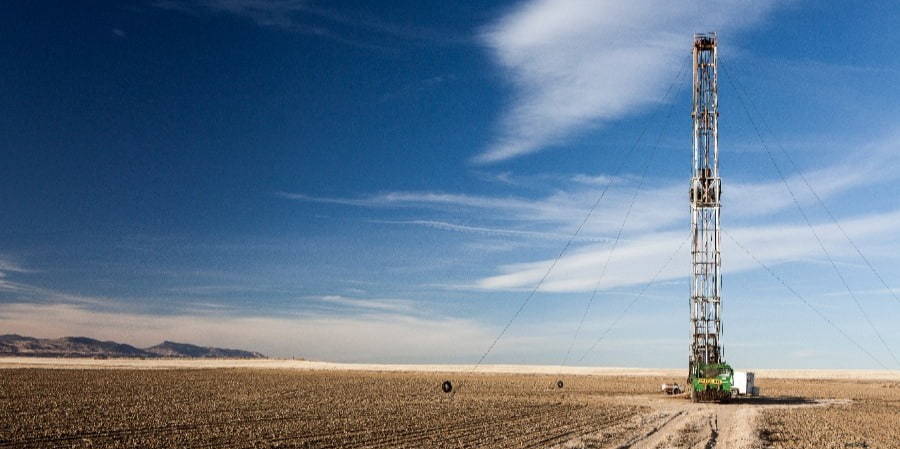A Brief History Of Fracking
31 Jul, 20226:41Following the peak of its conventional oil production in the early to mid-1970s it was assum...

Following the peak of its conventional oil production in the early to mid-1970s it was assumed that the American oil industry was facing an irreversible decline. Today, however, the picture couldn’t be more different! Oil production is expected to reach an epic 10 million barrels per day by the early 2020s, with the result that the American oil and gas industry is very much back in business, bringing with it jobs, growth and prosperity. And it’s thanks to what at first seemed to be a minor technological breakthrough- hydraulic fracturing.
So where did hydraulic fracturing come from? How did it develop? Who were the key players? Read on to find the answers to these questions and more as we provide you with a brief history of fracking.
To Frack or to Frac?
Before we go on however, we must address an issue which has proven divisive amongst engineers and associated oil industry professionals. When talking about hydraulic fracturing in the short-hand is the correct term Frack or Frac?
We are aware, following conversations and comments from EngineeringPro readers, that the preferred term amongst oil and gas operators and oilfield service providers is ‘Frac’. However, it’s the term ‘Frack’ that has gained traction amongst the commentariat and popular culture alike. As the old saying goes ‘everything is downstream from culture’ so we’ve decided to go ahead with the use of Frack for the sake of simplicity and popular understanding.
With that explanation out of the way, let’s get on with the history lesson!
1860s
The process of fracturing to activate shallow, hard rock wells dates back to the 1860s. The first fracking-related patent for an ‘oil well torpedo’ was filed in April 1865 by Edward Roberts, who went on to found a company which specialised in ‘shooting the well’. To put this innovation into context, the first productive oil well in the United States had only been drilled less than a decade previously in 1858, so Roberts, a Civil War veteran, was well ahead of the still developing industry.
Roberts quickly figured out that simply fracturing the rock wasn’t sufficient. He began using an additional process called ‘fluid tamping’, effectively filling the borehole with water. According to the Seismological Society of America, “The technique had an immediate impact - production from some wells increased 1,200 percent within a week of being shot.” Although the scale and technique has evolved since Roberts, the basic principle of fracking remains the same to this today according to the Society.
1947
The immediate post-war period saw the birth of modern-day fracking. In 1947, Floyd Farris of Stanolind Oil & Gas began a study on the relationship between oil and gas production output and the amount of pressurised treatment applied to each well. This study led to the first modern day example of hydraulic fracturing at the Hugoton gas field in Kansas which saw the technique used to extract natural gas from limestone.
During this experimental frack, 1,000 US gallons of napalm (gelled gasoline) was injected into the gas producing limestone formation with a depth of 2,400 feet. This was then followed up with a gel breaker to ‘frack’ the well. Unfortunately, this particular experiment was deemed a failure as it didn’t lead to any significant increase in production. Nevertheless, the first modern frack had been carried out.
1949
In steps oilfield services giant Halliburton, which is still a major player in hydraulic fracturing today. In 1949, a patent was issued with an exclusive licence approved for the Halliburton Oil Well Cementing Company. On March 17th that same year, the company carried out the first two successful commercial hydraulic fracturing treatments; one in Stephens county, Oklahoma, and another in Archer County, Texas.
According to a spokesman from Halliburton:
“Since that fateful day in 1949, hydraulic fracturing has done more to increase recoverable reserves than any other technique, and Halliburton has led the industry in developing and applying fracturing technology. In the more than 60 years following those first treatments, more than two million fracturing treatments have been pumped with no documented case of any treatment polluting an aquifer - not one.”
Following Halliburton’s success, fracking quickly became commercially scaled-up with operators such as Pan American Petroleum (the successor company of Stanolind Oil & Gas) quickly making use of the technique to develop basins in Oklahoma and beyond.
1953
Once hydraulic fracturing become commercialised, it wasn’t long before operators were experimenting and making iterative changes to make the process quicker and more affordable. 1953 saw a significant leap forward when water and gelling agents replaced napalm and other petroleum products in the injection process.
1965
By the mid-1960s hydraulic fracturing had spread beyond America’s coasts and had landed in the UK, with the first hydraulic fracturing of an offshore UK well taking place at the North Sea well West Sole, 42 miles east of the Humber.
The mid-1960s also saw the first hydraulic fracturing of shale formations take place. Operators in southern West Virginia & eastern Kentucky successfully fracked the Ohio & Cleveland Shale. It was at this time that it became clear that the technique could be used to consistently improve production from lower-yielding wells.
1968
By the late-1960s operators such as Pan American Petroleum were undertaking high-volume hydraulic fracturing in Oklahoma. This form of high-volume hydraulic fracturing could see the injection of over 130 tonnes of proppant into an oil or gas well.
Late 1970s
From the late-1970s onwards hydraulic fracturing has been commonly used in North Sea oil and gas fields, especially as reserves become increasingly challenging to exploit.
1980s
It was during the 1980s that things went horizontal for hydraulic fracturing. Prior to this period horizontal oil and gas wells were largely unheard of. In the Austin Chalk, Texas, operators began to initiate thousands of wells by drilling horizontally and providing large slickwater hydraulic fracturing treatments to the wellbores.
It was also during this period that the industry saw the emergence of George P. Mitchell (founder of Mitchell Energy) whose company took the pioneering step into the hydraulic fracturing of shales on a scale which had heretofore not been attempted. Thanks to these efforts, and his almost obsessive persistence to perfect the technique, Mitchell was eventually hailed as the ‘father of fracking’.
On the other side of the Atlantic, hydraulic fracturing had spread onshore. Since then the use of hydraulic fracturing at 200 onshore wells has been routine since the early 1980s.
1981
By 1981 hydraulic fracturing was making its first use of digital technology with the use of microseismic monitoring of operations. First introduced by Sandia Laboratory, modern microseismic monitoring technology in hydraulic fracturing uses surface and near surface detectors. As the reservoir rock breaks during fracking, a popping noise is detected, recorded and projected back to determine its location. The result? A more effective application of hydraulic fracturing to the well.
1992-1996
The early to mid-1990s saw further experiments and utilisation of microseismic monitoring in relation to fracked wells. Much of the experimentation during this period was carried out by the Department of Energy and the Gas Research Institute at ‘M-Site’ near Colorado.
2000
It’s at this point that a name familiar to many of you comes into the picture - the Barnett Shale. It was in 2000 that the Barnett Shale was successfully mapped using microseismic imaging.
2002
The early 2000s saw the techniques of horizontal drilling, microseismic mapping and slickwater fracking being combined signaling the beginning of the ‘twenty-first century’ fracking that we know today.
2003
2003 was the point at which many historians and industry analysts agree the shale revolution began. Named the ‘shale gale’, 2003 saw the beginning of the golden age of the independent operator, with equity and privately backed firms such as EOG Resources, Chesapeake, Devon, Continental, Pioneer and many many others buying up substantial amounts of acreage across the continental United States.
2012
Fast forward to 2012 and the results of the shale gale had become clear, with an estimated 2.5 million fracking applications having been performed worldwide on oil and gas wells - more than one million of these taking place in the US.
2016
By 2016 fracking accounted for more than 50% of all oil output according to the Energy Information Administration. Considering that in 2000 fracking accounted for less than 2% of the US’s oil output, you can clearly see how big the shale gale ended up being.
The 2016 oil output was driven by 300,000 fracking wells producing 4.3 million barrels per day. 2016 also saw the UK trying to emulate the success of the US fracking industry, with exploratory fracking activity approved at locations including Lancashire, Nottinghamshire, and Yorkshire.
2019
Today, hydraulic fracturing continues to transfer the oil and gas industry, especially in the US where a once declining industry has been completely revived by the technology. By December 2018, US shale oil production stood at 8m barrels per day and continues to increase with the IEA suggested that production could reach a plateau of 9-10m barrels per day by the early 2020s. It’s a similar success story with regards to natural gas, with 90% of the natural gas used in the United States being produced domestically.
Outside of the US numerous other countries are making tentative steps into fracking. China, desperate to secure domestic sources of energy, is eager to tap into shale following the decline of its conventional resources and booming demand. The UK meanwhile, has potentially enormous reserves of shale gas, but the country’s nascent fracking industry remains tied up in legislative and bureaucratic wrangling.
Fracking and jobs
With fracking having completely revived the US oil and gas industry and promising to do the same for other countries who choose to embrace this technology, it is also having a very positive impact on the engineering and technical jobs market.
In the US it was estimated that between 2005 and 2012 the fracking industry generated in excess of 750,000 jobs (according to a study from Dartmouth College). A separate study from the National Bureau of Economic Research analysed data from over 3,000 US counties and determined that within 100 miles of new production, $1 million of extracted oil and gas generated $234,000 in waves, $117,000 in royalties and 2.49 jobs.
Whichever way you cut it, hydraulic fracturing seems to have arrived at just the right time for the oil and gas jobs market.
Find your next Oil & Gas job with NES Fircroft
As the global leader in recruitment and workforce solutions to the oil and gas industry NES Fircroft is well placed to help you secure your next premium job role.
Since 1970 we’ve served the biggest operators in oil and gas and enjoy an enviable reputation for excellent contractor customer care. Open up a world of opportunity and register your resume / CV with NES Fircroft today and be the first in line to secure employment on the leading oil and gas projects.
If you’re a Hiring Manager or Project lead seeking to secure the best engineering and technical talent for your oil and gas project, explore NES Fircroft’s comprehensive range of award-winning services and request a free consultation now.










